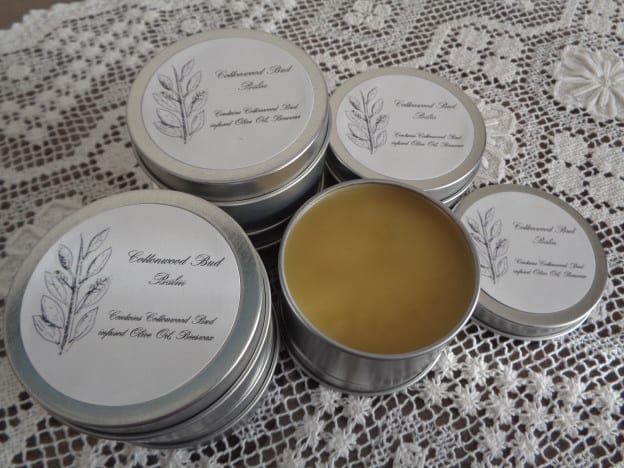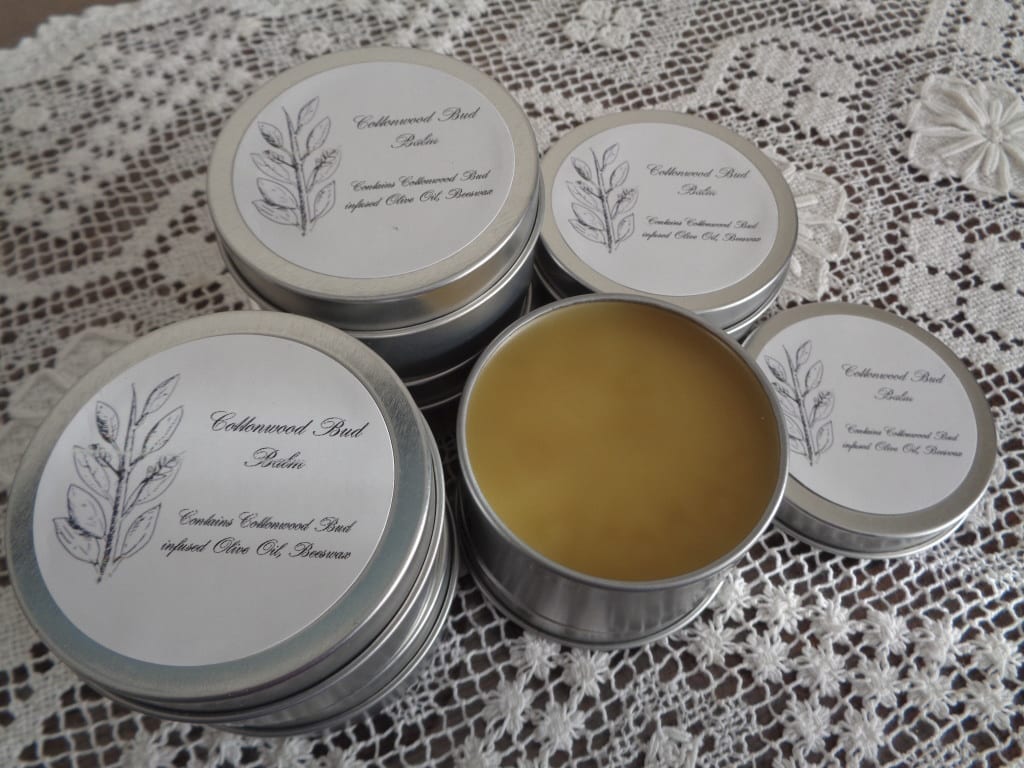 Have you ever been driving down the road or looking out the window during the summer to see great amounts of white fluff floating through the air? Sort of a cross between fluffy snowflakes and dandelion seeds, wafting everywhere?
Have you ever been driving down the road or looking out the window during the summer to see great amounts of white fluff floating through the air? Sort of a cross between fluffy snowflakes and dandelion seeds, wafting everywhere?
That is cottonwood. It is a member of the poplar family and the resin filled buds from the tree make a lovely salve for easing aches and pains. Cottonwood roots like water, usually easy to find in southern B.C. where there are trees readily available. If you live in a drier part of the world, try river banks and lakes in your search.
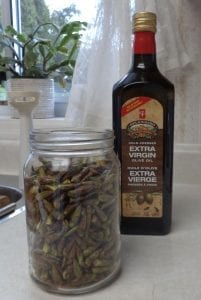 The branches of the tree break off easily and when the spring storms come, you can find them on the ground, ready for easy collection. Wear gloves! The resin gets on everything and as you will see a few pictures further down, it is best to reuse the same glass for next years batch as it will probably never be really clean again. Although I have never tried this, I have heard a rumor that vodka works but really, unless it was important, I have other uses for alcohol.
The branches of the tree break off easily and when the spring storms come, you can find them on the ground, ready for easy collection. Wear gloves! The resin gets on everything and as you will see a few pictures further down, it is best to reuse the same glass for next years batch as it will probably never be really clean again. Although I have never tried this, I have heard a rumor that vodka works but really, unless it was important, I have other uses for alcohol.
Like any project of this nature, be aware of air polution and choose buds that come from the cleanest area you can find, not along a busy street. Collect the buds by breaking them away from the fallen branches and when you feel you have enough, add olive oil and set them in a dark place to allow all the good stuff to move into olive oil. The buds and oil need to sit for at least six weeks, longer is better and a year is not unheard of.
Do not fill jar with buds to the top as in the picture to the right but rather to about half full as in the picture below. It is a good idea to leave enough room so that the mixture can be stirred regularly and you will find the buds swell as they fill with oil so leave a little extra room to accomodate the expansion. I missed that step the first time I soaked buds and found oil all over several shelves.
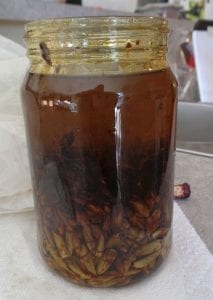 I used the lid of the jar but another way it is to use a piece of paper towel and canning ring to keep a little air flow happening. This also allows any water to evaporate.
I used the lid of the jar but another way it is to use a piece of paper towel and canning ring to keep a little air flow happening. This also allows any water to evaporate.
Fill the remaining space in the jar with a good olive oil. I will leave the choice of organic, or non, extra virgin or virgin up to you as the quality of what is available differs from area to area.
Now let’s chat about the year wait time, I mentioned above. I am posting this information now because, depending on your climate, the ideal time to gather is happening soon, however in a different year, you may be able to gather all you need after a late fall storm. Cottonwood grows like a rhododendron in that the bud is formed the previous summer. Letting the oil mixture sit longer allows for more transferring of the natural healing ingredients from the bud to the oil, six weeks is a minimum. It is possible to push the process along by heating the entire mixture gently before straining and cutting down the wait time but since there was no rush, I went without the extra heat. This batch was made at about seven months. Remember to stir regularly, keeping the buds in oil. It is possible that the mixture will get moldy if the buds are left to sit above the oil in the open air.
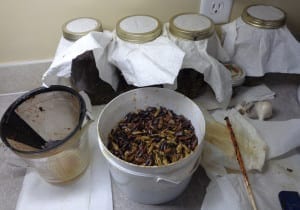 If you have been reading My Kitchen Wand posts for awhile, you know I have been blessed with access to a wonderful garden filled with lots of herbs and other plants. Jean and I get to experiment with a variety of recipes and you get the benefit of all the playing. This weekend, Jean and I got together and finally made the salve. That is her hand in the picture below. You can see in the picture to the right the jars that have been sitting and maturing, the container of soaked, strained buds, the stick with resin firmly attached and a measuring cup and coffee filter for help with the straining.
If you have been reading My Kitchen Wand posts for awhile, you know I have been blessed with access to a wonderful garden filled with lots of herbs and other plants. Jean and I get to experiment with a variety of recipes and you get the benefit of all the playing. This weekend, Jean and I got together and finally made the salve. That is her hand in the picture below. You can see in the picture to the right the jars that have been sitting and maturing, the container of soaked, strained buds, the stick with resin firmly attached and a measuring cup and coffee filter for help with the straining.
Letting the buds sit and drip for at least 30 minutes will help get more oil from the buds.
 Once the oil is separated, have a sniff. Jean says it smells like spring.
Once the oil is separated, have a sniff. Jean says it smells like spring.
Measure your oil and decide on the amount of beeswax you would like.
Some recipes use one part beeswax to five parts oil ( which I have done in the past ) and others use 1 cup oil to one ounce beeswax ( which we did this time ).
Do not feel that there is a hard and fast rule. You will not make a mistake if you use a little less or a little more.
What will happen is that 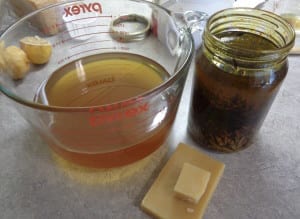 your salve will be a little thicker or a little softer and you might naturally make that adjustment to get closer to the consistency that works for you anyway.
your salve will be a little thicker or a little softer and you might naturally make that adjustment to get closer to the consistency that works for you anyway.
Measure out the oil and the beeswax. If you have chunks, like in the picture, cut them up as small as you can and you will reduce the wait time as the wax melts. Grating works too but weigh after grating not before and be prepared for a cleaning job with your grater afterwards.
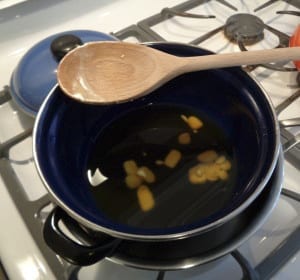 Other options include natural beeswax sheets which are already thin and can be easily torn or pastilles.
Other options include natural beeswax sheets which are already thin and can be easily torn or pastilles.
Using a double boiler or two pots that will fit inside each other, add the beeswax and the a small portion of the oil. The addition of the oil will assist in melting the beesawax as it engulfs the wax and brings heat to all its sides.
If two pots are being used instead of a double boiler, please ensure that the steam coming from the water in the bottom pot does not burn you while stirring.
Once the wax is fully melted into the portion of 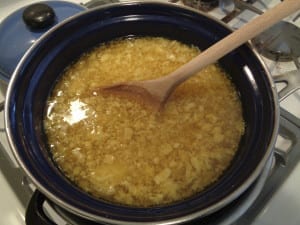 olive oil in the pot, it is time to mix in the remaining olive oil.
olive oil in the pot, it is time to mix in the remaining olive oil.
There are two ways to do this. One is to simply pour in the oil. If your oil is sitting at room temperature this will solidify the melted beeswax which needs a temperature of over 144 degrees Fahrenheit to remain liquid. There is no problem if you do this.
Simply stir and as the oil heats, the wax will remelt.
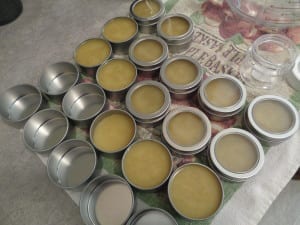 Option two is to heat the oil separately and pour the warmed oil (147 degrees Fahrenheit) into the beeswax mixture. If you use this method the beeswax will not solidify and there will be more pots to wash when finished.
Option two is to heat the oil separately and pour the warmed oil (147 degrees Fahrenheit) into the beeswax mixture. If you use this method the beeswax will not solidify and there will be more pots to wash when finished.
Transfer the salve to a jug with a good spout and handle. Pour into containers and allow the containers to cool. As the mixture cools the clear liquid will go solid and turn opaque. Clean out any solidified salve from the pouring container, remelt and repour until all the salve has been transferred to containers.
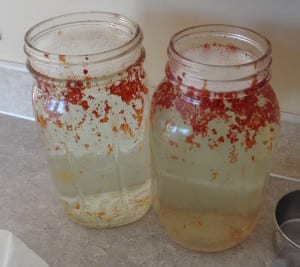 Feel free to use any left overs on all available arms and legs.
Feel free to use any left overs on all available arms and legs.
As mentioned, the jars will probably never come clean so hopefully there is room to store them until it is time to collect buds again.
Cottonwood bud salve is used a number of ways. Being an analgesic, it can calm pain. Its antimicrobial qualities help to take care of infections and being an anti-inflammatory it counters the body’s response to irritation or injury by reducing redness, warmth and swelling.
This post is not intended as a substitute for medical advise. Please see a healtcare professional if you have a condition that concerns you and persists.
Label and store at room temperature or below, ready for the right moment for a breath of spring and a calming rub on someone’s skin.
Cottonwood Bud Salve from My Kitchen Wand

